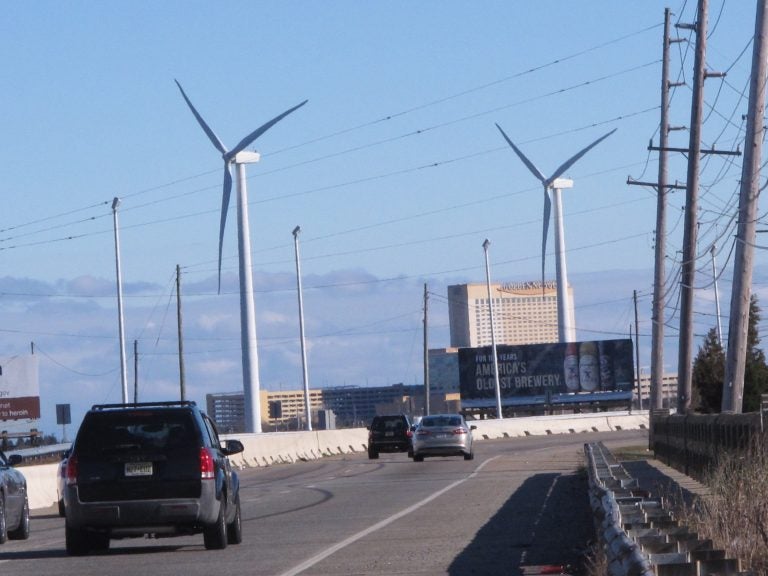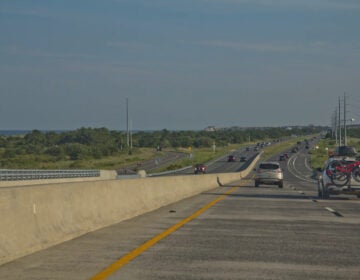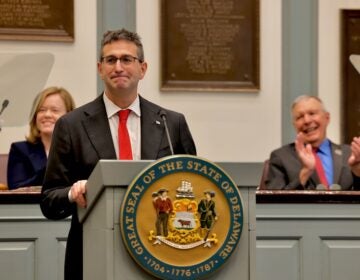N.J.’s new-look energy plan is delayed, now expected in December
Gov. Phil Murphy's overhaul of New Jersey’s Energy Master Plan is being put off while urgent energy issues are being dealt with.

Cars drive past windmills on the grounds of a sewage treatment plant in Atlantic City, N.J. on Monday Jan. 4, 2016. (Wayne Parry/AP Photo)
This story originally appeared on NJ Spotlight.
—
The state is pushing back adoption of a presumably radically revamped Energy Master Plan until the end of the year.
The New Jersey Board of Public Utilities is notifying stakeholders the plan, touted as a road map to guide the Murphy administration’s goal of achieving 100 percent clean energy by 2050, will not come out in draft form until June and now, in a final version by December.
Gov. Phil Murphy issued an executive order last spring ordering a new plan from the agency, asking it to be finalized by this June as part of his clean-energy agenda. With the BPU wrestling with an array of more timely and urgent energy issues, that time frame has been dropped, although not surprising to some.
It comes after the agency this week made a significant decision about the state’s energy mix for the future, approving a controversial $300 million a year ratepayer subsidy to keep PSEG Power’s three nuclear units open for at least the next three years, and possibly longer.
It also comes less than two weeks after BPU president Joseph Fiordaliso had told reporters the draft plan would be come out in “the next few weeks.’’ The plan is of intense interest because it is expected to dramatically shift the focus of the existing EMP, which concentrated on building out the state’s natural gas infrastructure.
Subject of many rumors
The extent of the shift has been a matter of wide-ranging speculation in and around Trenton. Rumors abounded that the administration was considering some type of moratorium on new natural gas projects, a priority of a coalition of environmentalists.
When asked earlier this month about the plan and whether natural gas would be phased out of the mix, Fiordaliso only would say that it, along with nuclear power, would be part of the state’s future energy mix.
At least nine natural gas pipeline projects are pending in New Jersey, as well as another four proposals to build natural gas power plants. Cheap natural gas has led to lower electricity prices for customers and huge drops in monthly bills for those who rely on the fuel to heat their homes during cold-weather months.
With 40 percent of the state’s electricity coming from natural gas and roughly 70 percent of homes and businesses heated by the fuel, it is unclear how the state can seamlessly phase out its use without huge impacts on consumers and the economy.
Peter Peretzman, a spokesman for the agency, said “we pushed backed the dates because we wanted to incorporate outstanding studies and additional stakeholder input to ensure a truly comprehensive and holistic plan.’’
‘…tensions inside the BPU’
As part of a sweeping clean-energy law signed nearly a year ago by the governor, the agency has initiated a number of studies to achieve the act’s goals, which include reducing energy consumption by gas and electric customers and promoting energy storage.
Energy storage is viewed as critical to achieving the state’s clean-energy goals since many renewable energy sources, like wind and solar, are intermittent. The state wants to create 600 megawatts of energy storage by 2021.
Ray Cantor, a vice president of the New Jersey Business & Industry Association, welcomed the delay in adopting the plan, saying that to go from a draft in April, as planned, to adoption in June would have allowed insufficient time to review and comment on the document.
“Given the tensions inside the BPU right now, it has to take longer,’’ said Jeff Tittel, director of the New Jersey Sierra Club, referring to the BPU’s approval of the nuclear subsidy contrasted with its staff’s finding that the facilities failed to demonstrate they qualify for the incentive.
The delay, however, means the agency will move forward with another big decision on the state’s future energy mix without having a new plan in place. By June, it is expected to decide what developers will build the first 1,100 MW of offshore-wind capacity off the Jersey Shore.
“We hope this to be a transformational plan and if it means a few more months, so be it,’’ said Doug O’Malley, director of Environment New Jersey. “We can’t afford the status quo and incremental progress.’’
WHYY is your source for fact-based, in-depth journalism and information. As a nonprofit organization, we rely on financial support from readers like you. Please give today.



